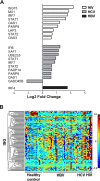Persistent Replication of HIV, Hepatitis C Virus (HCV), and HBV Results in Distinct Gene Expression Profiles by Human NK Cells
- PMID: 30185599
- PMCID: PMC6475777
- DOI: 10.1128/JVI.00575-18
Persistent Replication of HIV, Hepatitis C Virus (HCV), and HBV Results in Distinct Gene Expression Profiles by Human NK Cells
Abstract
Natural killer (NK) cells during chronic viral infection have been well studied in the past. We performed an unbiased next-generation RNA-sequencing approach to identify commonalities or differences of the effect of HIV, HCV, and HBV viremia on NK cell transcriptomes. Using cell sorting, we obtained CD3- CD56+ NK cells from blood of 6 HIV-, 8 HCV-, and 32 HBV-infected patients without treatment. After library preparation and sequencing, we used an in-house analytic pipeline to compare expression levels with matched healthy controls. In NK cells from HIV-, HCV-, and HBV-infected patients, transcriptome analysis identified 272, 53, and 56 differentially expressed genes, respectively (fold change, >1.5; q-value, 0.2). Interferon-stimulated genes were induced in NK cells from HIV/HCV patients, but not during HBV infection. HIV viremia downregulated ribosome assembly genes in NK cells. In HBV-infected patients, viral load and alanine aminotransferase (ALT) variation had little effect on genes related to NK effector function. In conclusion, we compare, for the first time, NK cell transcripts of viremic HIV, HCV, and HBV patients. We clearly demonstrate distinctive NK cell gene signatures in three different populations, suggestive for a different degree of functional alterations of the NK cell compartment compared to healthy individuals.IMPORTANCE Three viruses exist that can result in persistently high viral loads in immunocompetent humans: human immunodeficiency virus (HIV), hepatitis C virus, and hepatitis B virus. In the last decades, by using flow cytometry and in vitro assays on NK cells from patients with these types of infections, several impairments have been established, particularly during and possibly contributing to HIV viremia. However, the background of NK cell impairments in viremic patients is not well understood. In this study, we describe the NK cell transcriptomes of patients with high viral loads of different etiologies. We clearly demonstrate distinctive NK cell gene signatures with regard to interferon-stimulated gene induction and the expression of genes coding for activation markers or proteins involved in cytotoxic action, as well immunological genes. This study provides important details necessary to uncover the origin of functional and phenotypical differences between viremic patients and healthy subjects and provides many leads that can be confirmed using future in vitro manipulation experiments.
Keywords: hepatitis B virus; hepatitis C virus; human immunodeficiency virus; natural killer cells.
Copyright © 2019 American Society for Microbiology.
Figures



Similar articles
-
HBsAg stimulates NKG2D receptor expression on natural killer cells and inhibits hepatitis C virus replication.Hepatobiliary Pancreat Dis Int. 2018 Jun;17(3):233-240. doi: 10.1016/j.hbpd.2018.03.010. Epub 2018 Mar 26. Hepatobiliary Pancreat Dis Int. 2018. PMID: 29625837
-
MicroRNA 130a Regulates both Hepatitis C Virus and Hepatitis B Virus Replication through a Central Metabolic Pathway.J Virol. 2018 Mar 14;92(7):e02009-17. doi: 10.1128/JVI.02009-17. Print 2018 Apr 1. J Virol. 2018. PMID: 29321333 Free PMC article.
-
Circulating CD56dim natural killer cells and CD56+ T cells that produce interferon-γ or interleukin-10 are expanded in asymptomatic, E antigen-negative patients with persistent hepatitis B virus infection.J Viral Hepat. 2015 Mar;22(3):335-45. doi: 10.1111/jvh.12299. Epub 2014 Sep 3. J Viral Hepat. 2015. PMID: 25186004
-
Advances in the treatment of hepatitis B virus/hepatitis C virus coinfection.Expert Opin Pharmacother. 2014 Jul;15(10):1337-49. doi: 10.1517/14656566.2014.913571. Epub 2014 Apr 29. Expert Opin Pharmacother. 2014. PMID: 24773464 Review.
-
Recent advances in the treatment of HIV/HBV and HIV/HCV co-infection.Mini Rev Med Chem. 2012 Aug;12(9):890-904. doi: 10.2174/138955712800959062. Mini Rev Med Chem. 2012. PMID: 22530578 Review.
Cited by
-
An integrative genomic analysis of transcriptional profiles identifies characteristic genes and patterns in HIV-infected long-term non-progressors and elite controllers.J Transl Med. 2019 Jan 21;17(1):35. doi: 10.1186/s12967-019-1777-7. J Transl Med. 2019. PMID: 30665429 Free PMC article.
-
Peripheral natural killer cells in chronic hepatitis B patients display multiple molecular features of T cell exhaustion.Elife. 2021 Jan 28;10:e60095. doi: 10.7554/eLife.60095. Elife. 2021. PMID: 33507150 Free PMC article.
-
Human Diversity of Killer Cell Immunoglobulin-Like Receptors and Human Leukocyte Antigen Class I Alleles and Ebola Virus Disease Outcomes.Emerg Infect Dis. 2021 Jan;27(1):76-84. doi: 10.3201/eid2701.202177. Emerg Infect Dis. 2021. PMID: 33350932 Free PMC article.
-
Gene Expression: the Key to Understanding HIV-1 Infection?Microbiol Mol Biol Rev. 2020 May 13;84(2):e00080-19. doi: 10.1128/MMBR.00080-19. Print 2020 May 20. Microbiol Mol Biol Rev. 2020. PMID: 32404327 Free PMC article. Review.
-
B-Cell Activation Gene Signature in Blood and Liver of Hepatitis B e Antigen-Positive Patients With Immune Active Chronic Hepatitis B.J Infect Dis. 2024 Dec 16;230(6):e1263-e1273. doi: 10.1093/infdis/jiae280. J Infect Dis. 2024. PMID: 38847286 Free PMC article.
References
-
- Alter G, Teigen N, Davis BT, Addo MM, Suscovich TJ, Waring MT, Streeck H, Johnston MN, Staller KD, Zaman MT, Yu XG, Lichterfeld M, Basgoz N, Rosenberg ES, Altfeld M. 2005. Sequential deregulation of NK cell subset distribution and function starting in acute HIV-1 infection. Blood 106:3366–3369. doi:10.1182/blood-2005-03-1100. - DOI - PubMed
Publication types
MeSH terms
LinkOut - more resources
Full Text Sources
Other Literature Sources
Medical
Molecular Biology Databases
Research Materials
Miscellaneous

